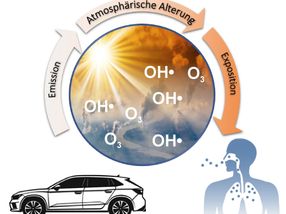How income and attitudes affect greenhouse gas emissions
Women consume less electricity
The higher the income of individuals living in Switzerland the higher their greenhouse gas emissions. But to what extent do differences in income actually have an effect on emissions, and to what extent do household emissions differ? The main differences were found in the areas of mobility and housing. For nutrition, the differences in individual emissions are less pronounced. These are the findings of a study conducted by social scientists at ETH Zurich

In terms of mobility, per capita emissions differ most in Switzerland.
pasja1000, pixabay.com, CC0
Switzerland aims at reducing its emissions of climate-relevant greenhouse gases. The behaviour of private households and individuals plays an important part in this endeavour. After all, a large proportion of emissions is caused by mobility, housing and food.
However, when looking at mobility, it becomes apparent that Switzerland is one of the world's most motorised societies, despite all the talk about electro-mobility and the availability of a highly developed public transport system, as is pointed out by Andreas Diekmann. The emeritus ETH Professor of Sociology heads the Environmental Research Group together with Ulf Liebe of the universities of Bern and Warwick (UK).
So is our talk about climate protection just that – talk? Are we not backing our words with action? Together with social scientist Heidi Bruderer Enzler, Diekmann has looked into this question. As part of the National Research Programme "Managing Energy Consumption" (NRP 71), they examined the extent to which emissions differ between individuals and households in Switzerland and the extent to which income and environmental awareness affect emissions. Particular attention was paid to the three emissions domains of mobility, housing and food.
For their study, they used data from the Swiss Environmental Survey 2007, which they were able to re-evaluate using an Empa eco-balancing procedure. They drew up life cycle assessments for all 3,400 or so respondents taken from all of Switzerland's linguistic regions.
Large differences in per capita emissions
The results of Bruderer Enzler and Diekmann have now appeared in the academic journals Energy Research and Social Science and Journal of Environmental Psychology. They found large individual differences in per capita emissions: the researchers compared the 10 percent of people whose per capita emissions were lowest (an average of 2,300kg CO2 per person) with the 10 percent who caused the most emissions (some 14,000kg CO2 per person).
This shows that the group with the highest emissions burdens the climate roughly six times more than the group with the lowest emissions. Accordingly, the 10 percent with the highest emissions generate around 23 percent of all emissions, the 10 percent with the lowest emissions just 4 percent.
The differences are most pronounced when it comes to mobility: the 10 percent emitting the most greenhouse gases are responsible for 23 times more emissions than the 10 percent that emit the least. In terms of housing, the emissions of the most prolific greenhouse gas emitters are 4.7 times higher, but only 1.3 times higher when it comes to food.
Limited effect of income
In a subsequent step, the researchers examined the influence of household income on emissions: as expected, greenhouse gas emissions increase with income. A comparison of the groups of the 10 percent with the highest and lowest incomes revealed that the group with the highest incomes emits about 1.8 times more greenhouse gases: "The fact that households with higher incomes have a greater impact on the environment comes as no surprise. The more income is available, the more gets consumed and the greater the actual environmental impact," says Diekmann.
What is surprising, however, is that the effect of income is lower than expected, as it accounts for just one tenth of the differences in emissions. As for climate gases from food, income plays no role; in Switzerland at least, food-related emissions do not differ according to income. This is where environmental awareness comes into play – such as whether someone prefers organic or vegan food.
Women consume less electricity
On the other hand, stronger income effects are discernible in housing – and particularly mobility. The overall modest effect of income on actual greenhouse gas emissions shows that environmental footprints can be very different within the same income bracket.
This provides room for manoeuvre: better-off households possess considerable scope for avoiding environmental pollution. This is even more effective if there are appropriate incentives for doing so – such as incentive taxes and the promotion of smart and energy-efficient technologies.
Gender also makes a difference: the ecological footprint of women is smaller than that of men. Bruderer Enzler and Diekmann demonstrated this with Ulf Liebe in a supplementary study on electricity consumption using the objectively measured data of an energy supplier. It appears that the electricity use of women in single-person households is almost one quarter lower than that of men living alone. "This difference endures even if one takes into account differences in income and home size," says Diekmann.
Apparent differences between linguistic regions
A comparison with symbolic forms of pro-environmental behaviour shows how important the life cycle analysis of households is: used by many studies for the sake of simplicity, this measures good intentions, such as when recycling, using self-brought shopping bags at the supermarket and other behaviours are gathered into one simple index.
Here, pro-environmental behaviour in German-speaking Switzerland, for example, appears to be considerably better than in the French-speaking Romandy – or Italian-speaking Ticino, come to that. If, on the other hand, one looks at the life cycle analysis of households, which is ultimately the decisive factor, there is no difference between the German-speaking east and French-speaking west of the country.
Yet this conceals significant discrepancies in mobility and housing, which cancel each other out: the environmental impact of mobility in the French-speaking region is higher than in German-speaking Switzerland, while exactly the opposite is true for housing.
What can be done to reduce the ecological impact of households? Every study points to the effectiveness of incentive taxes, says Diekmann. “The reimbursement of payments could even benefit low-income sections of society, since their environmental footprints are smaller than those of better-off households. In addition, there are 'soft' incentives, little psychological 'nudges' whose effectiveness the Environmental Research Group is currently investigating in field experiments with energy suppliers.”
Original publication
Bruderer Enzler H., Diekmann A.; "All Talk and No Action? An analysis of environmental concern, in-come and greenhouse gas emissions in Switzerland"; Energy Research and Social Science; 2019, 51, 12-19.
Bruderer Enzler, H., Diekmann, A., Liebe, U.; "Do environmental concern and future orientation predict metered household electricity use?"; Journal of Environmental Psychology; 2019, 62, 22-29.































































